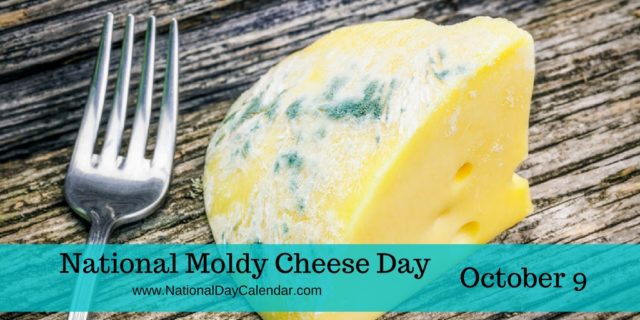
Updated March 24, 2024
National Moldy Cheese Day is a unique holiday that is observed each year on October 9.
A cheesemonger is a person who specializes in cheeses, butter, and other dairy products. They may take offense at the common person’s offense of moldy cheese. Well, depending on the type of mold of course. Some cheese molds, red or brown tinged molds, for example, are offensive. Toss those bacteria contaminated moldy cheeses in the garbage quickly and move along to the grey, blue or green colored moldy cheeses in the fridge instead.
Like a sommelier pairs the best wines with meals, a cheesemonger provides expert advice on artisan cheeses for recipes, banquets, and sources for restaurants.
Cheeses such as Maytag blue, Roquefort, Brie, bleu, camembert, gorgonzola, and Stilton are a few of the moldy reasons this day is celebrated.
- 8000 BC – Earliest dates proposed for the origin of cheesemaking range from around 8000 B.C.
- 1200 BC – World’s oldest cheese is found in ancient Egyptian tombs dating to this period.
- 1815 – The first factory for the industrial production of cheese opens in Switzerland.
- 1851 – however successful mass production began in 1851 in the United States.
- 2014 – World production of cheese from cow milk hits 18.7 million tons, with the United States accounting for 29%.
- The #1 cheese recipe in America is “Macaroni and Cheese”.
- What appears to be the remains of cheese has been found in Egyptian tombs over 4,000 years old!
- The terms “Big Wheel” and “Big Cheese” originally referred to those who were wealthy enough to purchase a whole wheel of cheese.
- Chevre is French for goat and refers to cheese made from goat’s milk.
- The word cheese comes from Latin caseus, from which the modern word casein is also derived. The earliest source is from the proto-Indo-European root *kwat-, which means “to ferment, become sour”.
- Ancient Greeks and Romans were the first to turn cheese making into a fine art. Larger Roman houses even had a special kitchen, called a careale, just for making cheese.
- People of Greece are the largest consumers of cheese worldwide. An average person from Greece consumes around 27.3 kilograms (60.1 pounds) of cheese every year, about 3/4 of which is feta cheese.On the second place is France and third is Iceland.
- Vieux Boulogne (a French cheese made with cows milk and washed in Beer) is widely considered to be the smelliest cheese in the world. Washed rind cheeses have a strong scent by nature. Stinking Bishop is an English cheese washed in fermented pear juice that also has quite a pong! Bear in mind that just because a cheese smells really whiffy, doesn’t necessarily mean that it tastes bad!
- The most expensive cheese in the world, Pule, Is Worth $576 per pound. Pule is an extremely rare cheese made in Serbia from donkey milk that was recently named the most expensive cheese in the world.
- Cheese made from Moose milk is successfully made on a farm in Sweden, despite the short lactation period of the Moose.It is second most expensive cheese in the world with price of $455 per pound.
- Studies have shown that eating cheese before bed can help you sleep.
- While France is known for its elegant (and sometimes nostril-assaulting) cheeses, our very own Wisconsin holds its own in the cheese department. The No. 1 producer of cheese in the United States, the state license plate boasts “America’s Dairyland” and state legislators even honored Lactococcus lactis, the bacterium used to make Colby, cheddar, and Monterey Jack, as Wisconsin’s official microbe.
- The idea for the foam Cheesehead was by Milwaukee native Ralph Bruno over 27 years. While reupholstering his mother’s couch, he had a leftover cushion. He randomly began burning holes into the foam rubber . Bruno painted the cushion yellow and affixed it to his head. Then he wore it to a baseball game between the Chicago White Sox and the Milwaukee Brewers. It caught on throughout the world of Wisconsin sports.
- There are three professional cheese sculptors in the United States.
Sources:












